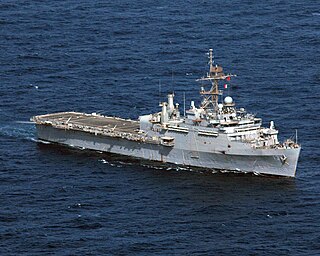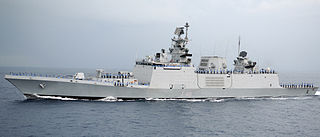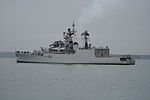
A carrier battle group (CVBG) is a naval fleet consisting of an aircraft carrier capital ship and its large number of escorts, together defining the group.

USS Nashville (LPD-13), an Austin-class amphibious transport dock, was the third ship of the United States Navy to be named for the capital city of Tennessee. Her keel was laid down on 14 March 1966 by the Lockheed Shipbuilding and Construction Company of Seattle, Washington. She was launched on 7 October 1967 sponsored by Mrs. Roy L. Johnson, and commissioned at Puget Sound Naval Shipyard, Bremerton, Washington, on 14 February 1970 with Captain Frank R. Fahland in command.

HMS Bulwark is the second ship of the Royal Navy's Albion-class assault ships. She is one of the United Kingdom's two amphibious transport docks designed to put Royal Marines ashore by air and by sea.

The Indian Navy is the naval branch of the Indian Armed Forces. The President of India is the Supreme Commander of the Indian Navy. The Chief of Naval Staff, a four-star admiral, commands the navy. It is one of the largest and most powerful navies in the world. As a blue-water navy, it operates significantly in Persian Gulf Region and the Horn of Africa to the Strait of Malacca, and routinely conducts anti-piracy operations and partnership building with other navies in the region. It also conducts routine two to three month-long deployments in the South and East China seas as well as the western Mediterranean simultaneously. The navy has a listening post in Madagascar.

Standing Royal Navy deployments is a list of operations and commitments undertaken by the United Kingdom's Royal Navy on a worldwide basis. The following list details these commitments and deployments sorted by region and in alphabetical order. Routine deployments made by the Navy's nuclear-powered submarines and their location of operations is classified.

The Bangladesh Navy is the naval warfare branch of the Bangladesh Armed Forces, responsible for Bangladesh's 118,813 square kilometres (45,874 sq mi) of maritime territorial area, and the defence of important harbours, military bases and economic zones. The primary role of the Bangladesh Navy is to protect the country's economic and military interests at home and abroad. The Bangladesh navy is also a front line disaster management force in Bangladesh, and participates in humanitarian missions abroad. It is a key regional player in counter terrorism efforts, and engages in global peacekeeping with the United Nations.

HMCS Charlottetown is a Halifax-class frigate that has served in the Royal Canadian Navy since 1995. Charlottetown is the tenth ship in her class which is based on the Canadian Patrol Frigate Project. She is the third vessel to carry the designation HMCS Charlottetown. Charlottetown, assigned to Maritime Forces Atlantic (MARLANT) and homeported at CFB Halifax, serves on missions protecting Canada's sovereignty in the Atlantic Ocean and enforcing Canadian laws in its territorial sea and exclusive economic zone. Charlottetown has also participated in several NATO missions, patrolling the Atlantic Ocean as part of Standing Naval Force Atlantic (STANAVFORLANT) and its successors Standing NATO Maritime Group 1 and 2. Charlottetown has also been deployed on missions throughout the Atlantic and to the Indian Ocean, specifically the Persian Gulf and Arabian Sea on anti-terrorism operations.

The Brahmaputra-class frigates are guided-missile frigates of the Indian Navy, designed and built in India. They are an enhancement of the Godavari class, with a displacement of 3850 tons and a length of 126 metres (413 ft). Although of similar hull and dimension, internally, the Brahmaputra and Godavari classes have different configurations, armaments and capabilities. 3 ships of this class serve in the Indian Navy.

The Godavari-class frigates are guided-missile frigates of the Indian Navy. The Godavari class was the first significant indigenous warship design and development initiative of the Indian Navy. Its design is a modification of the Nilgiri class with a focus on indigenous content of 72%, a larger hull and updated armaments.

INS Tabar (F44) is the third of the Talwar-class frigate of the Indian Navy. The frigate was commissioned on 19 April 2004 in Kaliningrad, Russia with Captain Biswajit Dasgupta. The current Commanding Officer (CO) of INS Tabar is Captain Mahesh Mangipudi.

HNLMS De Ruyter is a De Zeven Provinciën-class frigate of the Royal Netherlands Navy. She was laid down in 2000, launched in 2002, and commissioned in 2004, the third ship of her class to enter service. The frigate is named after Dutch admiral Michiel de Ruyter (1607–1676).

The Shivalik class or Project 17 class is a class of multi-role stealth frigates in service with the Indian Navy. They are the first stealth warships built in India. They were designed to have better stealth features and land-attack capabilities than the preceding Talwar-class frigates. A total of three ships were built between 2000 and 2010, and all three were in commission by 2012.
Operation Sukoon was an operation launched by the Indian Navy to evacuate Indian, Sri Lankan and Nepalese nationals, as well as Lebanese nationals with Indian spouses, from the conflict zone during the 2006 Lebanon War.

The Myanmar Navy is the naval warfare branch of the armed forces of Myanmar. With 24,000 personnel on duty, the navy operates more than 150 vessels. Prior to 1988, the navy was small, and its role in counter-insurgency operations was smaller than those of the army and the air force. The navy has since been expanded to take on a more active role in defense of Myanmar's territorial waters.

INS Shivalik (F47) is the lead ship of her class of stealth multi-role frigates built for the Indian Navy. She is the first stealth warship built by India. She was built at the Mazagon Dock Limited (MDL) located in Mumbai. Construction of the vessel began in 2001 and was completed by 2009. She underwent sea trials from thereon before being commissioned on 29 April 2010.

INS Betwa (F39) is a Brahmaputra-class guided missile frigate currently in service with the Indian Navy. The ship is named for the Betwa River.

INS Beas (F37) is a Brahmaputra-class frigate of the Indian Navy. She was built at the Garden Reach Shipbuilders and Engineers (GRSE), Kolkata.

INS Talwar (F40) is the lead ship of the Talwar-class frigates of the Indian Navy. Its name means "Sword" in Hindi. She was built in Russia, and commissioned into the Indian Navy on 18 June 2003.

INS Shakti (A57) is a Deepak-class fleet tanker in service with the Indian Navy. She was built by Fincantieri, an Italian shipbuilding company based in Trieste. She is the second and final ship of her class. Shakti, along with her predecessor Deepak, is one of the largest ships of the Indian Navy.






















